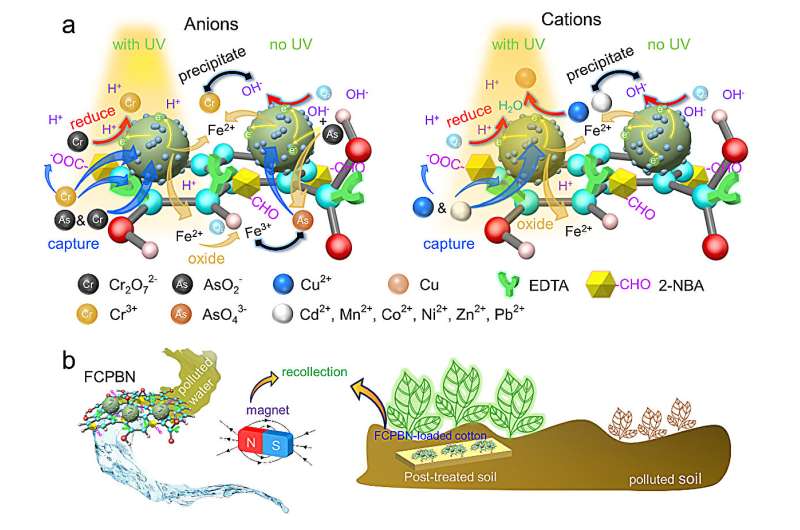This article has been reviewed according to Science X's editorial process and policies. Editors have highlighted the following attributes while ensuring the content's credibility:
fact-checked
peer-reviewed publication
proofread
Researchers design nano primary battery system for remediating diverse heavy metal ions

A team led by Prof. Wu Zhengyan and Zhang Jia from the Hefei Institutes of Physical Science of the Chinese Academy of Sciences has synthesized a versatile, broad-spectrum Fe/Cu primary battery-based nanocomposite with photo-induced protonation effect to immobilize diverse heavy metal ions. This system has a large number of active sites, which makes it have a strong trapping and immobilization effect on highly-stable heavy metal ions (HMIs).
The results were published in Journal of Hazardous Materials.
Existing remediation strategies struggle to effectively remove a variety of oppositely charged HMIs without releasing toxic substances. To address this, researchers constructed a primary battery-based nanocomposite, with photo-induced protonation effect, for effectively consolidating oppositely charged HMIs, which tackles an environmental application challenge.
In this research, the team first fabricated a primary battery then modified the graphite oxide (GO) with ethylenediaminetetraacetic acid (EDTA) and the photo-protonated molecule 2-nitrobenzaldehyde (2-NBA), fabricating a Fe/Cu primary battery-based nanocomposite (FCPBN) with photo-induced protonation effect. These formulations further enhanced the adsorption of HMIs and proton-induced precipitation reactions.
Additionally, the FCPBN exhibits promising removal performance on scavenging HMIs from water including Cr(VI), As(III), Cd(II), Pb(II), Mn(II), Zn(II), Co(II), Ni(II), and Cu(II) to trace levels, meeting the standards of drinking water in China, and also has a better remediation of Cr(VI)- and Cd(II)-contaminated soil collected from Chizhou, Anhui Province.
"This innovative approach could lead to more efficient and environment-friendly HMIs remediation in the future, supporting sustainable environmental development," said Ge, first author of the paper.
More information: Hongjian Ge et al, Photo-induced protonation assisted nano primary battery for highly efficient immobilization of diverse heavy metal ions, Journal of Hazardous Materials (2024). DOI: 10.1016/j.jhazmat.2024.135066



















